Abstract
OBJECTIVE: To review the concept of population health, including its definition, measurement, and determinants, and to suggest an approach for aligning financial incentives toward this goal. DATA SOURCE, STUDY DESIGN, DATA EXTRACTION. Literature review, policy analysis PRINCIPAL FINDINGS: The article presents the argument that a major reason for our slow progress toward health outcome improvement is that there is no operational definition of population health and that financial incentives are not aligned to this goal. Current attempts at process measures as indicators of quality or outcome are not adequate for the task. It is suggested that some measure of health-adjusted life expectancy be adopted for this purpose, and that integrated delivery systems and other agents responsible for nonmedical determinants be rewarded for improvement in this measure. This will require the development of an investment portfolio across the determinants of health based on relative marginal return to health, with horizontal integration strategies across sectoral boundaries. A 20-year three-phase development strategy is proposed, including components of research and acceptance, integrated health system implementation, and cross-sectoral integration. CONCLUSIONS: The U.S. healthcare system is a $1 trillion industry without a definition of its product. Until population outcome measures are developed and rewarded for, we will not solve the twenty-first century challenge of maximizing health outcome improvement for the resources available.
Full text
PDF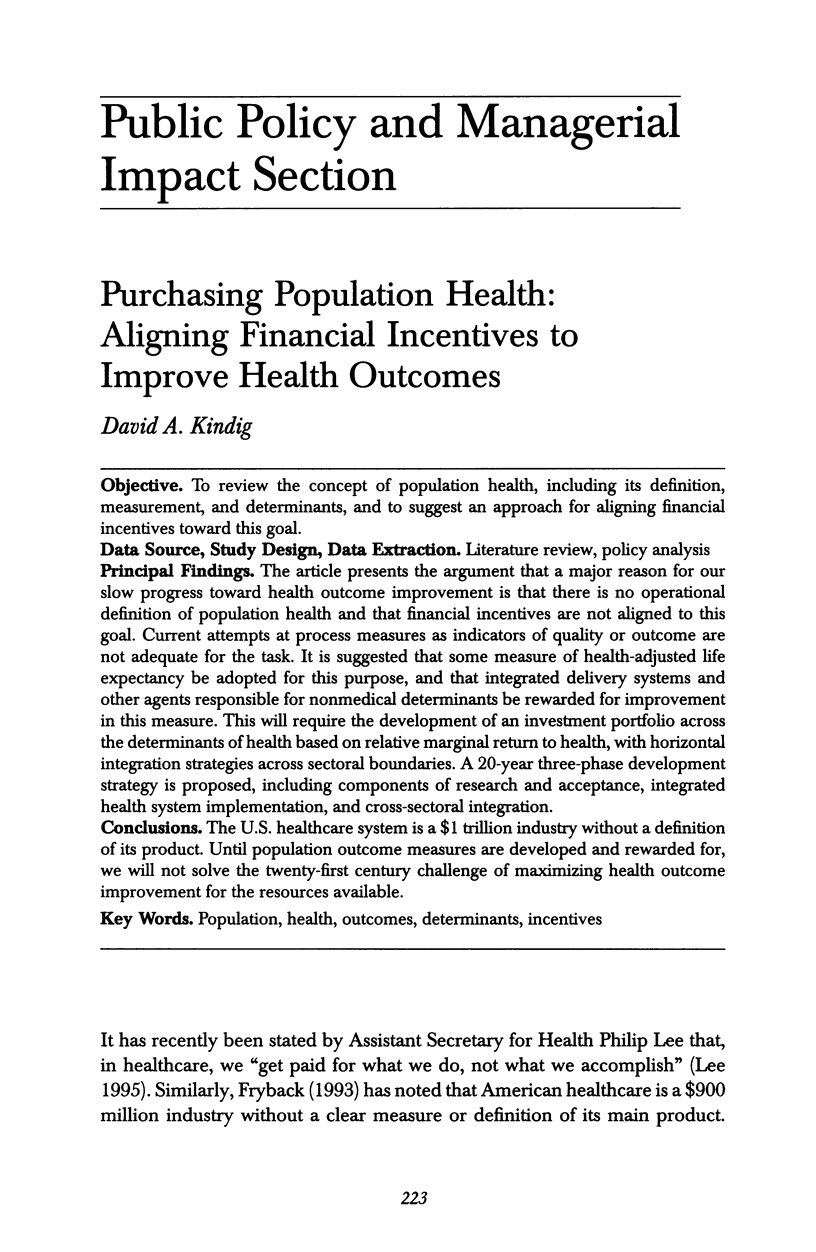
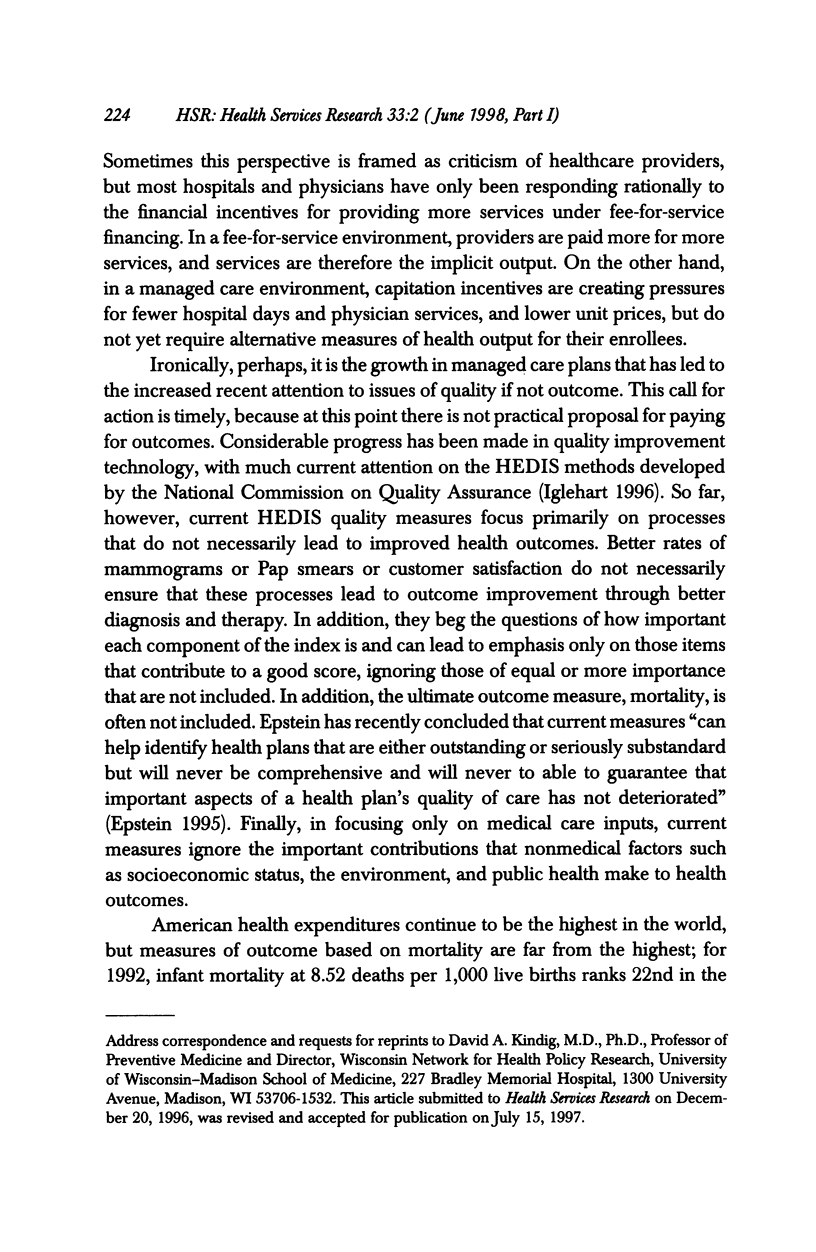
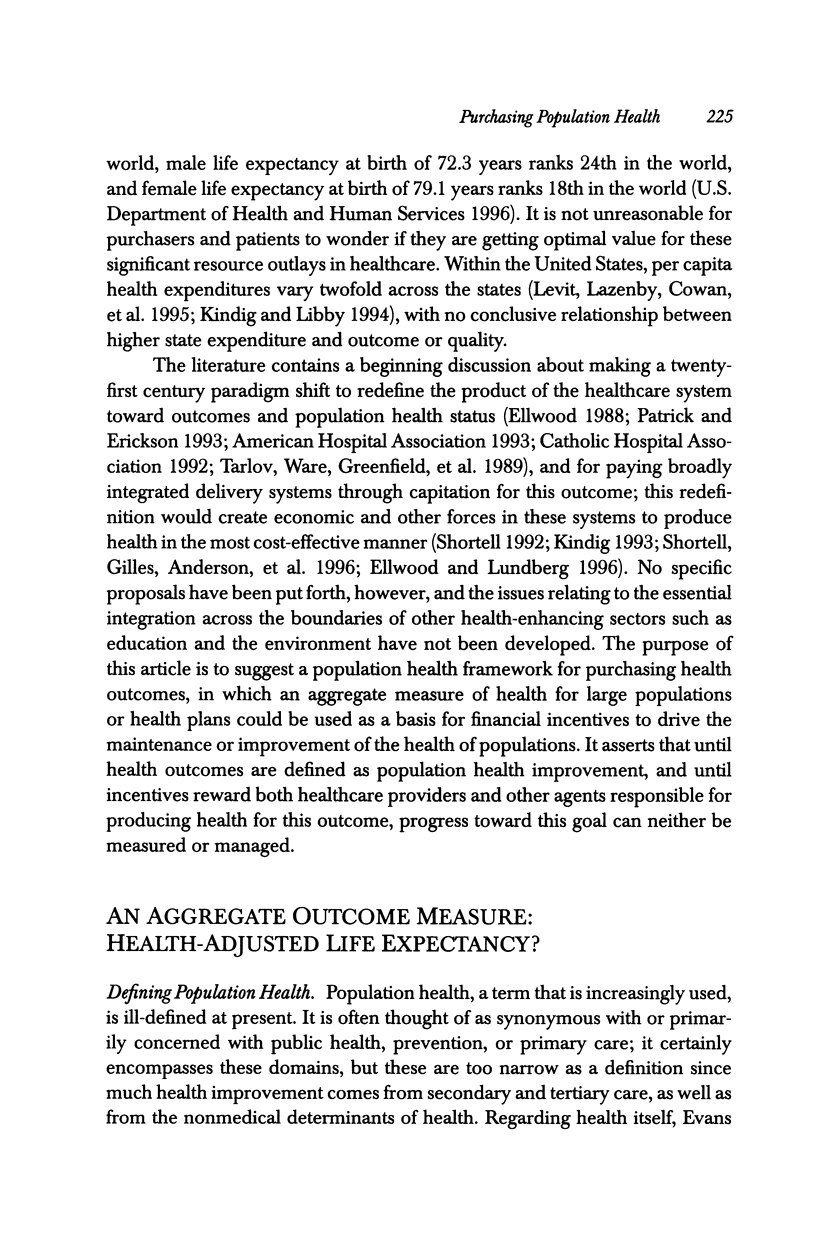

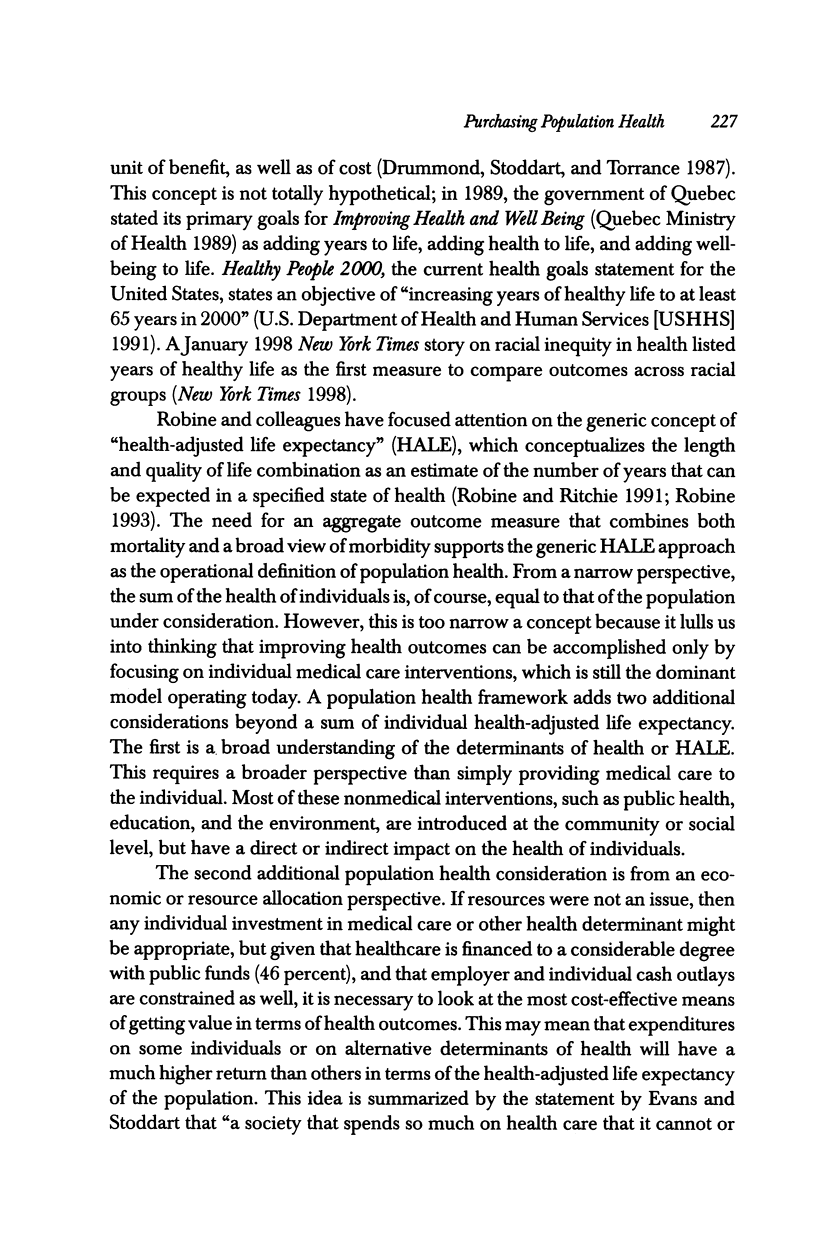

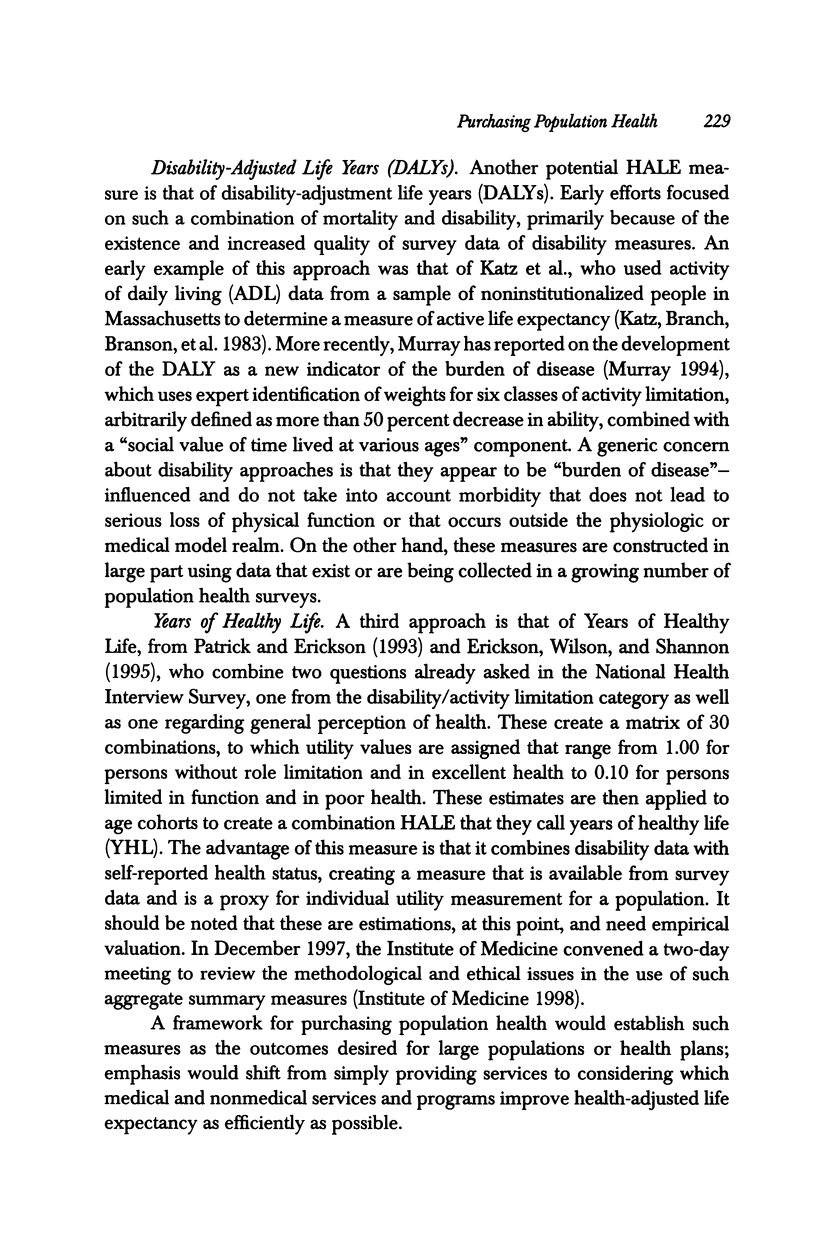
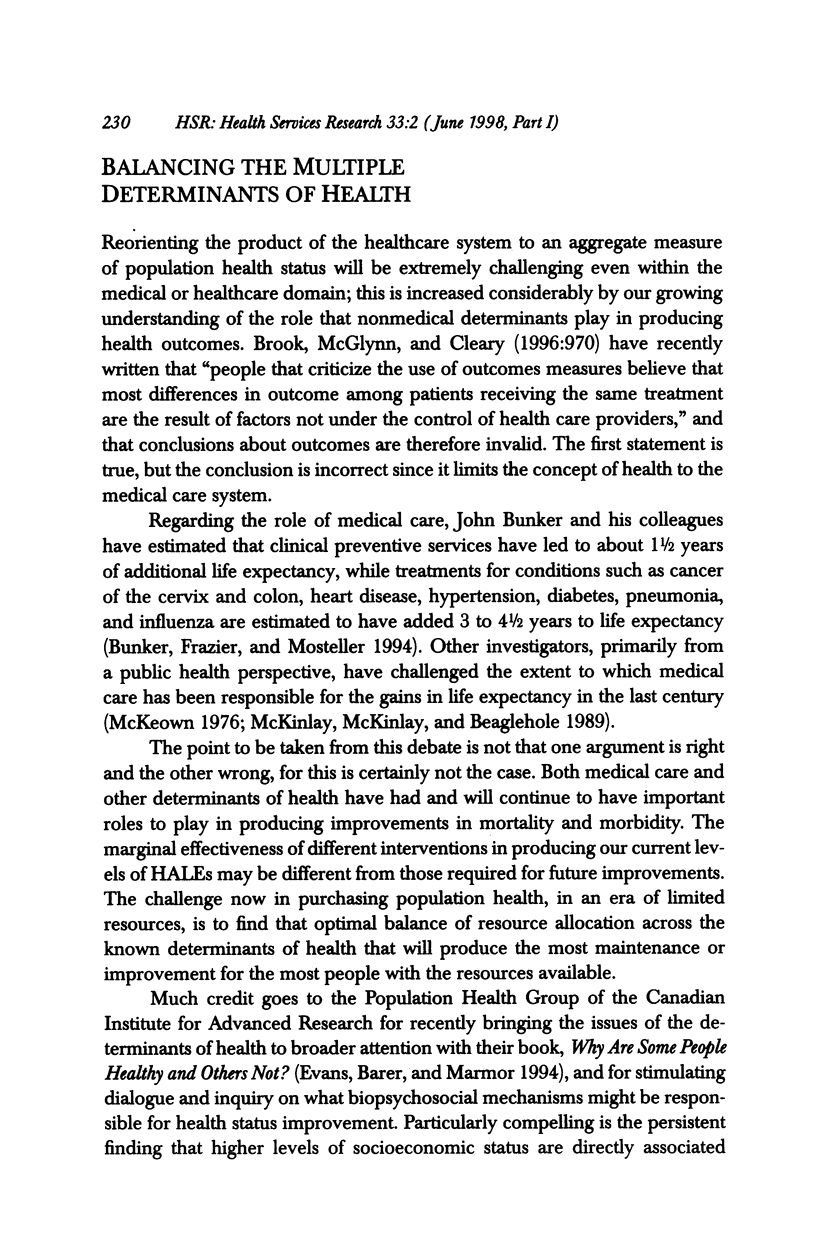
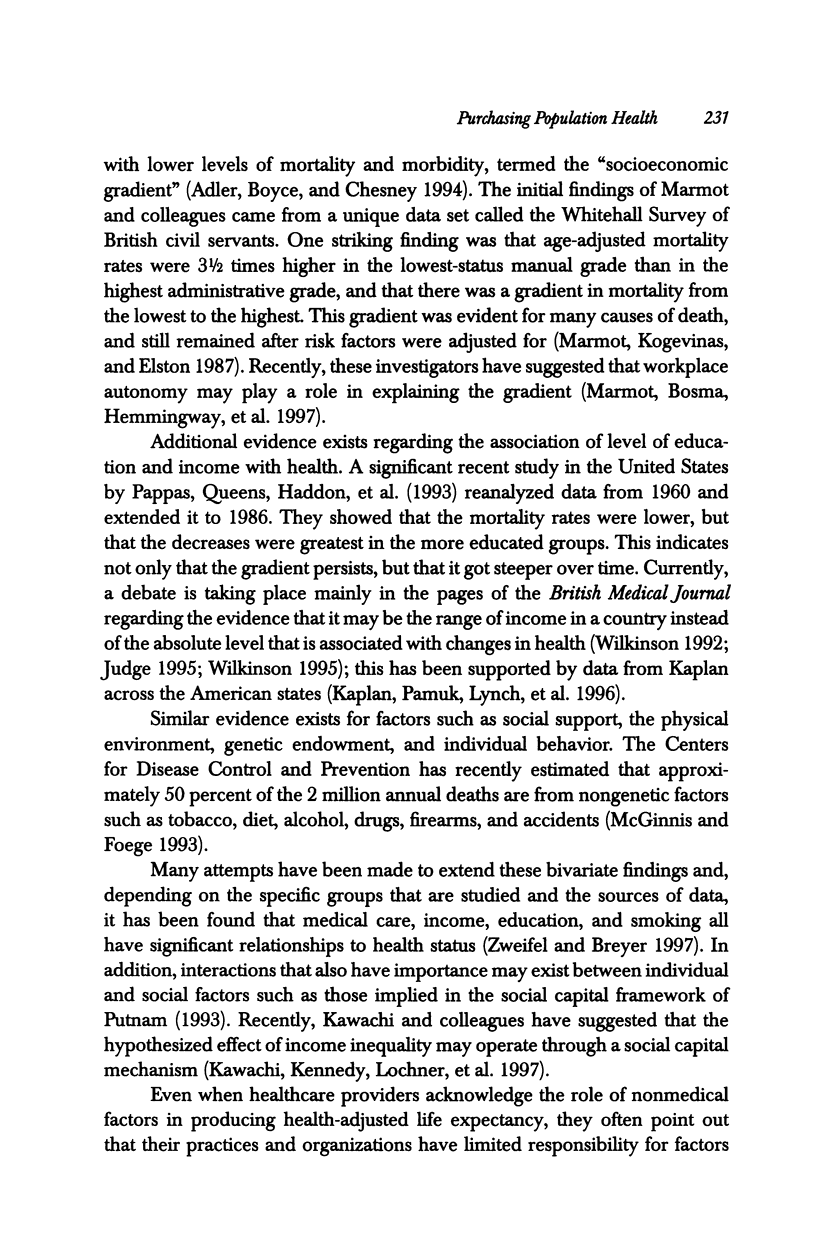
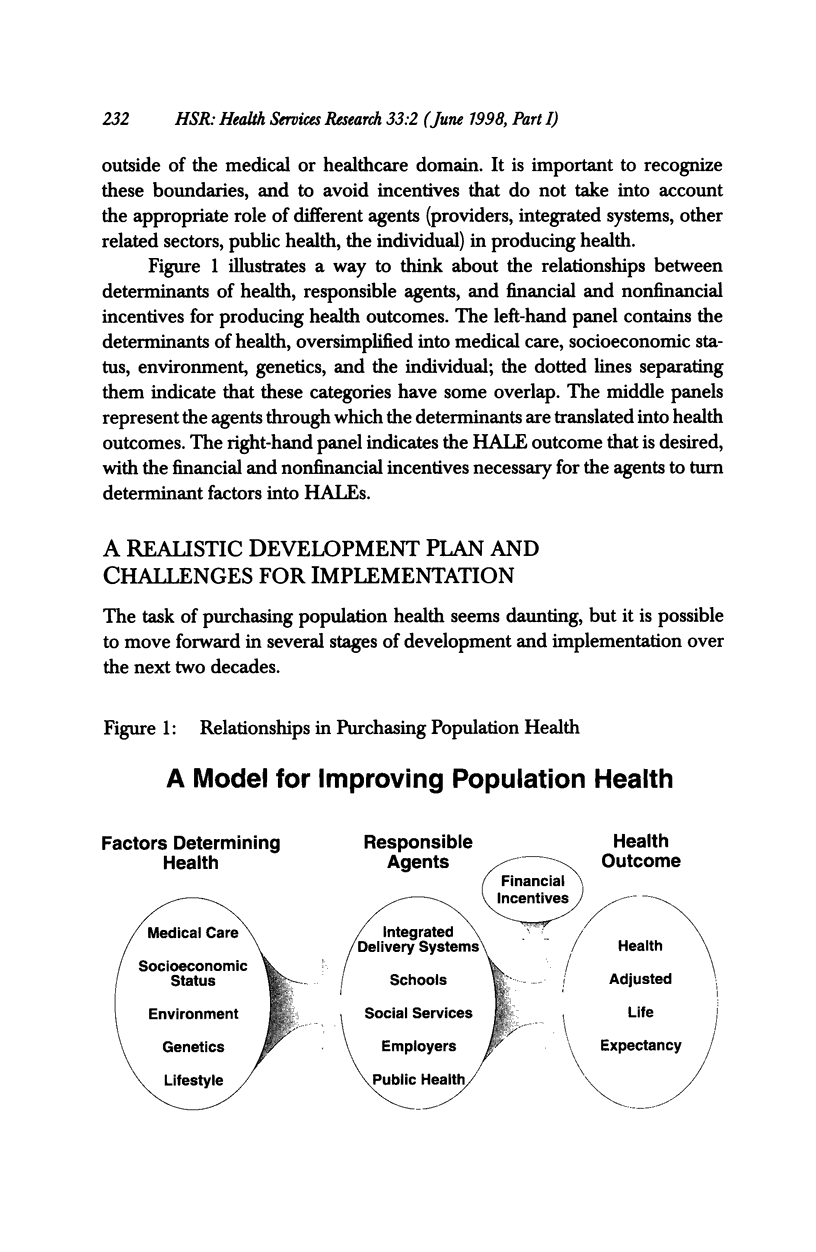

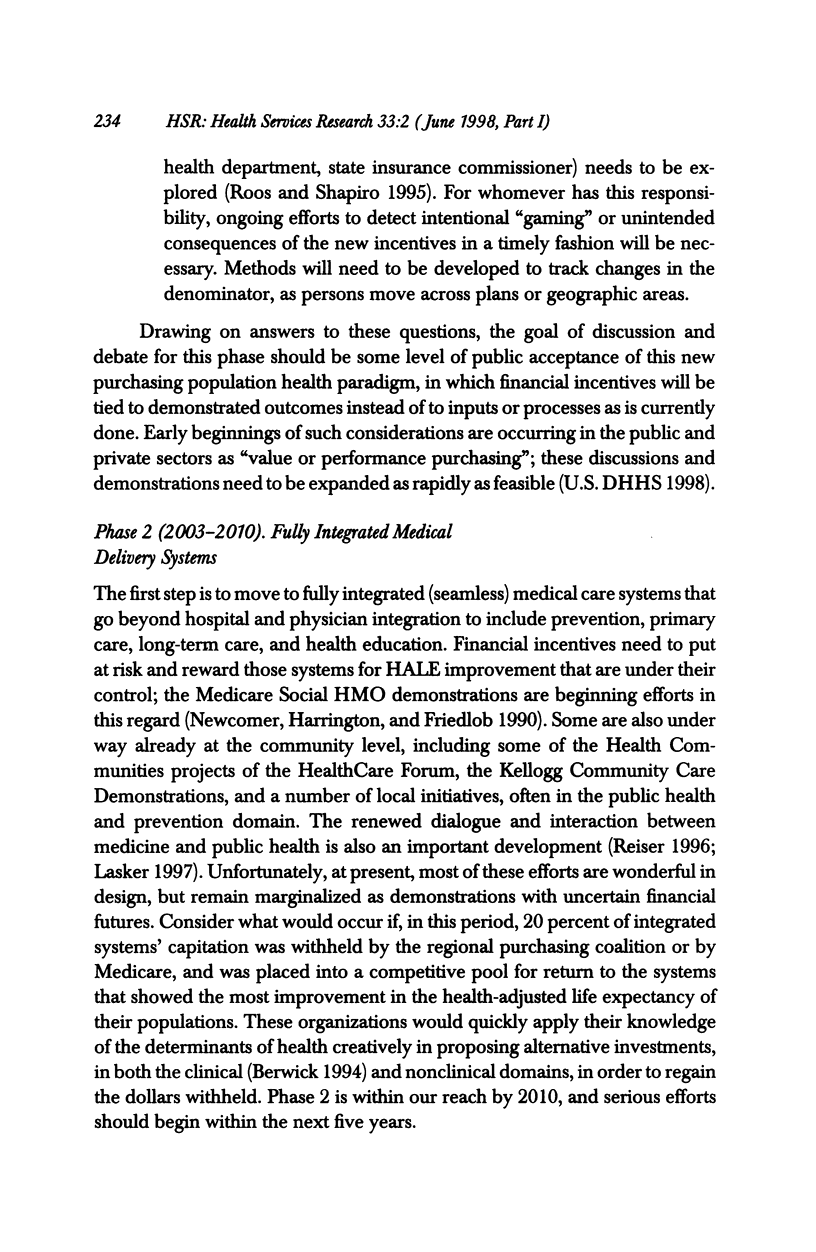


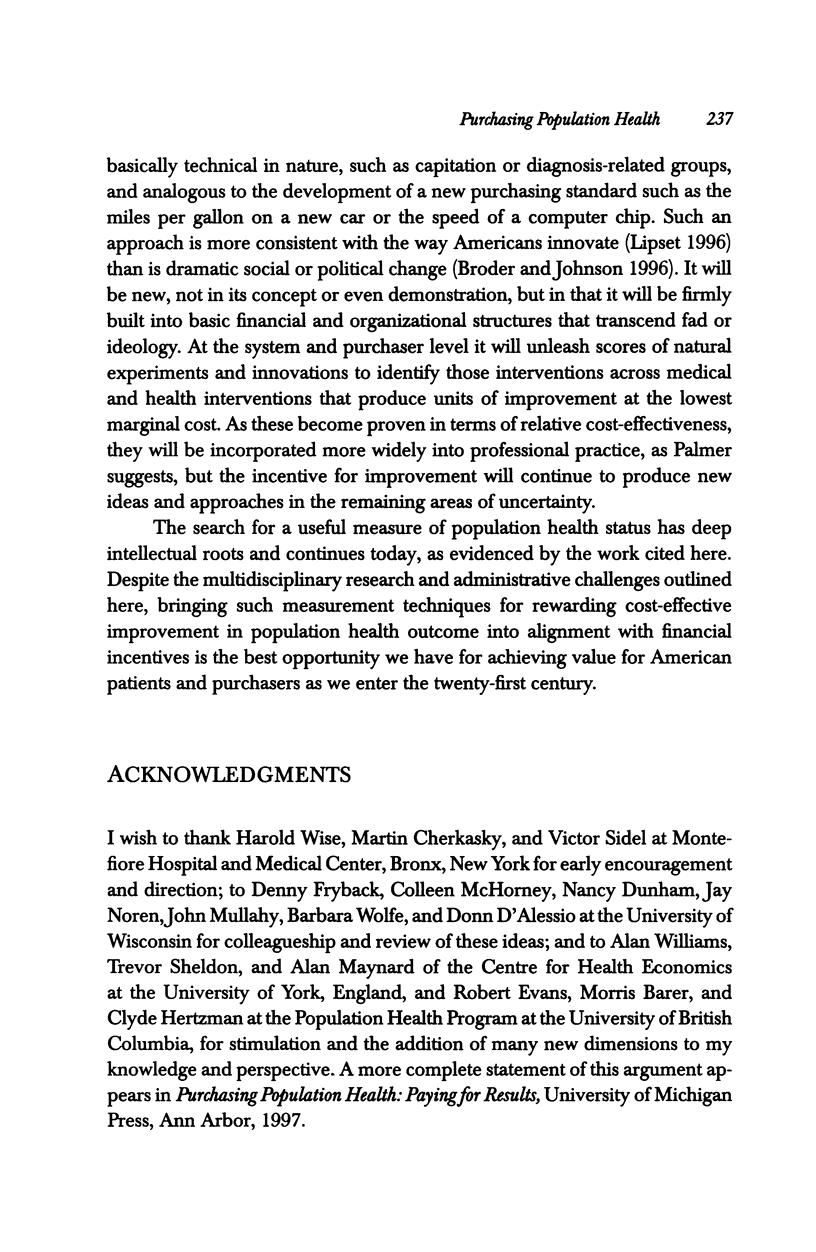
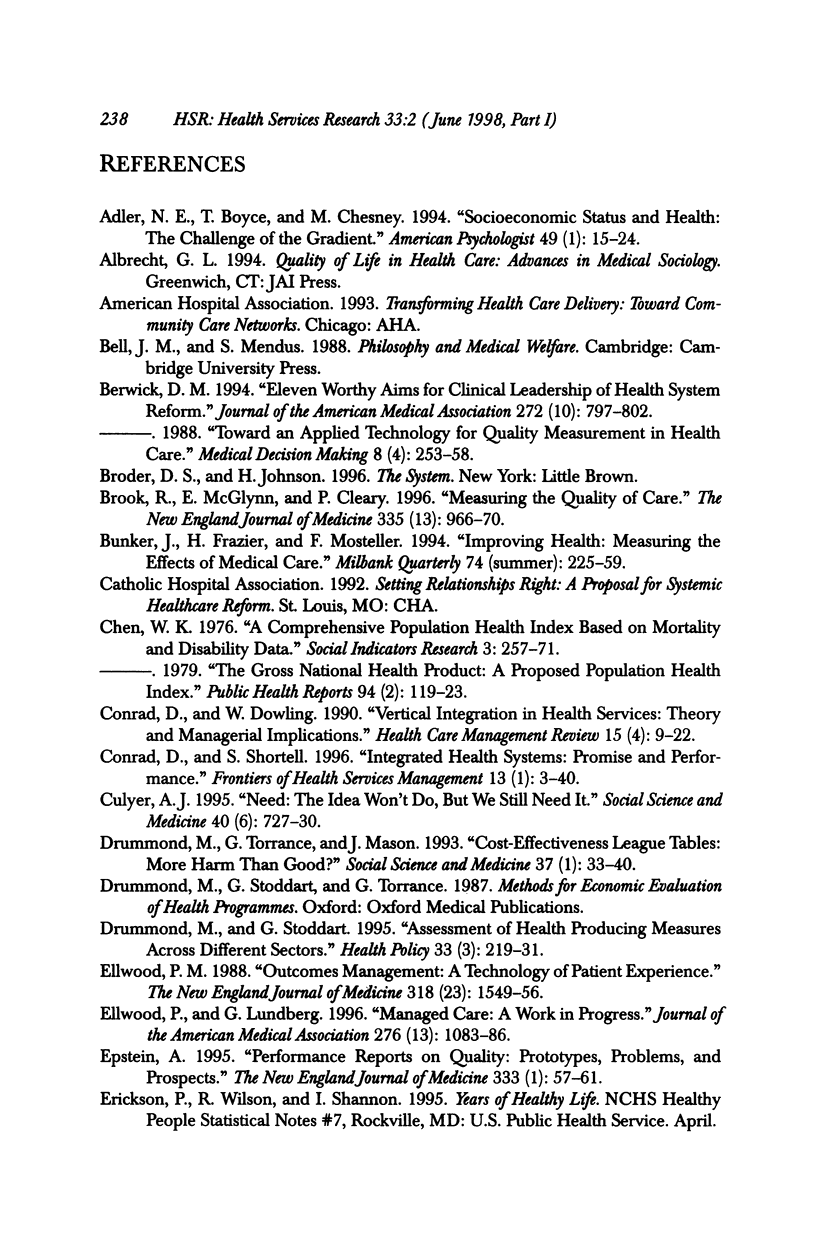


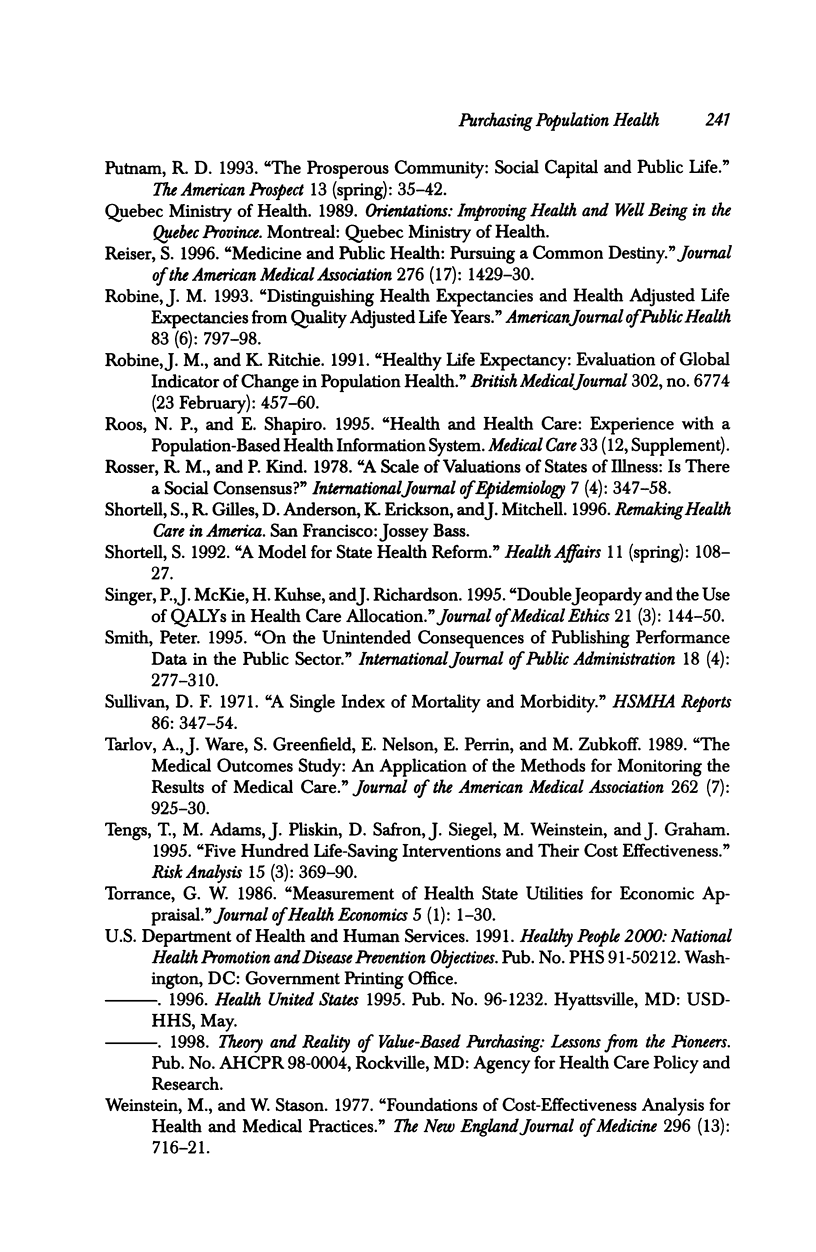
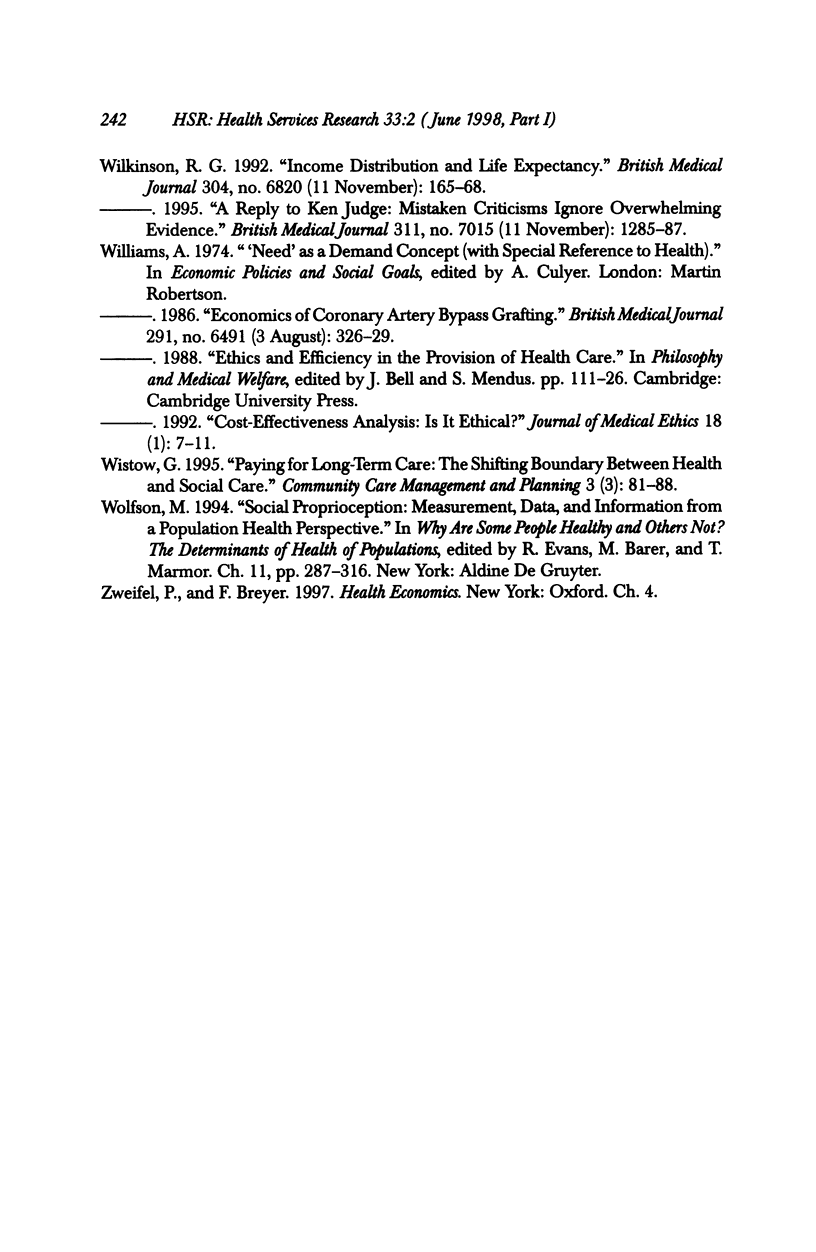
Images in this article
Selected References
These references are in PubMed. This may not be the complete list of references from this article.
- Adler N. E., Boyce T., Chesney M. A., Cohen S., Folkman S., Kahn R. L., Syme S. L. Socioeconomic status and health. The challenge of the gradient. Am Psychol. 1994 Jan;49(1):15–24. doi: 10.1037//0003-066x.49.1.15. [DOI] [PubMed] [Google Scholar]
- Berwick D. M. Eleven worthy aims for clinical leadership of health system reform. JAMA. 1994 Sep 14;272(10):797–802. [PubMed] [Google Scholar]
- Brook R. H., McGlynn E. A., Cleary P. D. Quality of health care. Part 2: measuring quality of care. N Engl J Med. 1996 Sep 26;335(13):966–970. doi: 10.1056/NEJM199609263351311. [DOI] [PubMed] [Google Scholar]
- Bunker J. P., Frazier H. S., Mosteller F. Improving health: measuring effects of medical care. Milbank Q. 1994;72(2):225–258. [PubMed] [Google Scholar]
- Conrad D. A., Dowling W. L. Vertical integration in health services: theory and managerial implications. Health Care Manage Rev. 1990 Fall;15(4):9–22. doi: 10.1097/00004010-199001540-00003. [DOI] [PubMed] [Google Scholar]
- Conrad D. A., Shortell S. M. Integrated health systems: promise and performance. Front Health Serv Manage. 1996 Fall;13(1):3–58. [PubMed] [Google Scholar]
- Culyer A. J. Need: the idea won't do--but we still need it. Soc Sci Med. 1995 Mar;40(6):727–730. doi: 10.1016/0277-9536(94)00307-f. [DOI] [PubMed] [Google Scholar]
- Drummond M., Stoddart G. Assessment of health producing measures across different sectors. Health Policy. 1995 Sep;33(3):219–231. doi: 10.1016/0168-8510(94)00717-s. [DOI] [PubMed] [Google Scholar]
- Drummond M., Torrance G., Mason J. Cost-effectiveness league tables: more harm than good? Soc Sci Med. 1993 Jul;37(1):33–40. doi: 10.1016/0277-9536(93)90315-u. [DOI] [PubMed] [Google Scholar]
- Ellwood P. M., Jr, Lundberg G. D. Managed care: a work in progress. JAMA. 1996 Oct 2;276(13):1083–1086. [PubMed] [Google Scholar]
- Ellwood P. M. Shattuck lecture--outcomes management. A technology of patient experience. N Engl J Med. 1988 Jun 9;318(23):1549–1556. doi: 10.1056/NEJM198806093182327. [DOI] [PubMed] [Google Scholar]
- Epstein A. Performance reports on quality--prototypes, problems, and prospects. N Engl J Med. 1995 Jul 6;333(1):57–61. doi: 10.1056/NEJM199507063330114. [DOI] [PubMed] [Google Scholar]
- Evans R. G., Stoddart G. L. Producing health, consuming health care. Soc Sci Med. 1990;31(12):1347–1363. doi: 10.1016/0277-9536(90)90074-3. [DOI] [PubMed] [Google Scholar]
- Fryback D. G. QALYs, HYEs, and the loss of innocence. Med Decis Making. 1993 Oct-Dec;13(4):271–272. doi: 10.1177/0272989X9301300401. [DOI] [PubMed] [Google Scholar]
- Goldsmith J. C. The illusive logic of integration. Healthc Forum J. 1994 Sep-Oct;37(5):26–31. [PubMed] [Google Scholar]
- Harris J. QALYfying the value of life. J Med Ethics. 1987 Sep;13(3):117–123. doi: 10.1136/jme.13.3.117. [DOI] [PMC free article] [PubMed] [Google Scholar]
- Iglehart J. K. The National Committee for Quality Assurance. N Engl J Med. 1996 Sep 26;335(13):995–999. doi: 10.1056/NEJM199609263351322. [DOI] [PubMed] [Google Scholar]
- Judge K. Income distribution and life expectancy: a critical appraisal. BMJ. 1995 Nov 11;311(7015):1282–1287. doi: 10.1136/bmj.311.7015.1282. [DOI] [PMC free article] [PubMed] [Google Scholar]
- Kaplan G. A., Pamuk E. R., Lynch J. W., Cohen R. D., Balfour J. L. Inequality in income and mortality in the United States: analysis of mortality and potential pathways. BMJ. 1996 Apr 20;312(7037):999–1003. doi: 10.1136/bmj.312.7037.999. [DOI] [PMC free article] [PubMed] [Google Scholar]
- Katz S., Branch L. G., Branson M. H., Papsidero J. A., Beck J. C., Greer D. S. Active life expectancy. N Engl J Med. 1983 Nov 17;309(20):1218–1224. doi: 10.1056/NEJM198311173092005. [DOI] [PubMed] [Google Scholar]
- Kawachi I., Kennedy B. P., Lochner K., Prothrow-Stith D. Social capital, income inequality, and mortality. Am J Public Health. 1997 Sep;87(9):1491–1498. doi: 10.2105/ajph.87.9.1491. [DOI] [PMC free article] [PubMed] [Google Scholar]
- Kindig D. A. Altering specialty balances. Physician Exec. 1993 Nov-Dec;19(6):79–80. [PubMed] [Google Scholar]
- Kindig D. A., Libby D. L. Setting state health spending limits. Health Aff (Millwood) 1994 Spring;13(2):288–289. doi: 10.1377/hlthaff.13.2.288. [DOI] [PubMed] [Google Scholar]
- Levit K. R., Lazenby H. C., Cowan C. A., Won D. K., Stiller J. M., Sivarajan L., Stewart M. State health expenditure accounts: building blocks for state health spending analysis. Health Care Financ Rev. 1995 Fall;17(1):201–254. [PMC free article] [PubMed] [Google Scholar]
- Marmot M. G., Bosma H., Hemingway H., Brunner E., Stansfeld S. Contribution of job control and other risk factors to social variations in coronary heart disease incidence. Lancet. 1997 Jul 26;350(9073):235–239. doi: 10.1016/s0140-6736(97)04244-x. [DOI] [PubMed] [Google Scholar]
- Marmot M. G., Kogevinas M., Elston M. A. Social/economic status and disease. Annu Rev Public Health. 1987;8:111–135. doi: 10.1146/annurev.pu.08.050187.000551. [DOI] [PubMed] [Google Scholar]
- McGinnis J. M., Foege W. H. Actual causes of death in the United States. JAMA. 1993 Nov 10;270(18):2207–2212. [PubMed] [Google Scholar]
- McKinlay J. B., McKinlay S. M., Beaglehole R. A review of the evidence concerning the impact of medical measures on recent mortality and morbidity in the United States. Int J Health Serv. 1989;19(2):181–208. doi: 10.2190/L73V-NLDL-G7H3-63JC. [DOI] [PubMed] [Google Scholar]
- Murray C. J. Quantifying the burden of disease: the technical basis for disability-adjusted life years. Bull World Health Organ. 1994;72(3):429–445. [PMC free article] [PubMed] [Google Scholar]
- Newcomer R., Harrington C., Friedlob A. Social Health Maintenance Organizations: assessing their initial experience. Health Serv Res. 1990 Aug;25(3):425–454. [PMC free article] [PubMed] [Google Scholar]
- Olsen J. A. Persons vs years: two ways of eliciting implicit weights. Health Econ. 1994 Jan-Feb;3(1):39–46. doi: 10.1002/hec.4730030106. [DOI] [PubMed] [Google Scholar]
- Palmer R. H. Securing health care quality for Medicare. Health Aff (Millwood) 1995 Winter;14(4):89–100. doi: 10.1377/hlthaff.14.4.89. [DOI] [PubMed] [Google Scholar]
- Pappas G., Queen S., Hadden W., Fisher G. The increasing disparity in mortality between socioeconomic groups in the United States, 1960 and 1986. N Engl J Med. 1993 Jul 8;329(2):103–109. doi: 10.1056/NEJM199307083290207. [DOI] [PubMed] [Google Scholar]
- Reiser S. J. Medicine and public health: pursuing a common destiny. JAMA. 1996 Nov 6;276(17):1429–1430. [PubMed] [Google Scholar]
- Robine J. M., Mathers C. D., Bucquet D. Distinguishing health expectancies and health-adjusted life expectancies from quality-adjusted life years. Am J Public Health. 1993 Jun;83(6):797–798. doi: 10.2105/ajph.83.6.797. [DOI] [PMC free article] [PubMed] [Google Scholar]
- Robine J. M., Ritchie K. Healthy life expectancy: evaluation of global indicator of change in population health. BMJ. 1991 Feb 23;302(6774):457–460. doi: 10.1136/bmj.302.6774.457. [DOI] [PMC free article] [PubMed] [Google Scholar]
- Rosser R., Kind P. A scale of valuations of states of illness: is there a social consensus? Int J Epidemiol. 1978 Dec;7(4):347–358. doi: 10.1093/ije/7.4.347. [DOI] [PubMed] [Google Scholar]
- Shortell S. M. A model for state health care reform. Health Aff (Millwood) 1992 Spring;11(1):108–127. doi: 10.1377/hlthaff.11.1.108. [DOI] [PubMed] [Google Scholar]
- Singer P., McKie J., Kuhse H., Richardson J. Double jeopardy and the use of QALYs in health care allocation. J Med Ethics. 1995 Jun;21(3):144–150. doi: 10.1136/jme.21.3.144. [DOI] [PMC free article] [PubMed] [Google Scholar]
- Sullivan D. F. A single index of mortality and morbidity. HSMHA Health Rep. 1971 Apr;86(4):347–354. [PMC free article] [PubMed] [Google Scholar]
- Tarlov A. R., Ware J. E., Jr, Greenfield S., Nelson E. C., Perrin E., Zubkoff M. The Medical Outcomes Study. An application of methods for monitoring the results of medical care. JAMA. 1989 Aug 18;262(7):925–930. doi: 10.1001/jama.262.7.925. [DOI] [PubMed] [Google Scholar]
- Tengs T. O., Adams M. E., Pliskin J. S., Safran D. G., Siegel J. E., Weinstein M. C., Graham J. D. Five-hundred life-saving interventions and their cost-effectiveness. Risk Anal. 1995 Jun;15(3):369–390. doi: 10.1111/j.1539-6924.1995.tb00330.x. [DOI] [PubMed] [Google Scholar]
- Torrance G. W. Measurement of health state utilities for economic appraisal. J Health Econ. 1986 Mar;5(1):1–30. doi: 10.1016/0167-6296(86)90020-2. [DOI] [PubMed] [Google Scholar]
- Weinstein M. C., Stason W. B. Foundations of cost-effectiveness analysis for health and medical practices. N Engl J Med. 1977 Mar 31;296(13):716–721. doi: 10.1056/NEJM197703312961304. [DOI] [PubMed] [Google Scholar]
- Wilkinson R. G. Income distribution and life expectancy. BMJ. 1992 Jan 18;304(6820):165–168. doi: 10.1136/bmj.304.6820.165. [DOI] [PMC free article] [PubMed] [Google Scholar]



